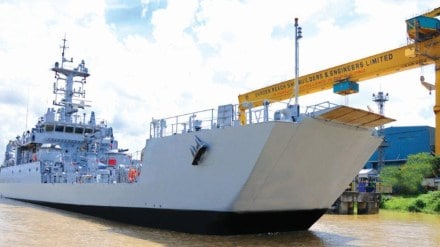By K Mohandas
India aims to be among the top five shipbuilding nations by 2047 and secure 5% share of the market in five years. It is a strategic multiplier industry, but achieving the targets will be challenged by the base effect. Shipyards must gear up to implement Industry 4.0, explains K Mohandas
What is the need for more Indian-owned ships?
Ships used in international trade represent the best in global human partnerships; the ownership, manufacture, registration and flagging, finance, manning, and cargo do not conform to usual national identities. However, international relations—political as well as commercial—can change dramatically over short periods. Globalisation has been in reverse mode in the recent past. Traditionally, merchant ships have been called the second line of naval defence; they ensure energy security and food security. They will come in handy for exports and imports when other countries, blocs, or even international organisations declare sanctions or restrictions affecting our national interest. When there is an embargo on the handling of Russian or Iranian oil, or on Chabahar Port built and managed by India, a strong commercial fleet would be an assertive sign of independence and self-reliance. These are times when the WTO and even the UN have reduced clout. India’s share of 1.2% in global tonnage is inadequate, even considering its share in global merchandise trade is pegged at 1.8%. Even in normal times, the forex outflow is massive.
Government actions to promote shipbuilding
Atmanirbhar Bharat is one of the key foundational planks for Viksit Bharat (developed India) goals set for 2047. The Amrit Kaal Vision 2047 for Logistics, Infrastructure and Shipping outlines ambitious plans to make India among the top five shipbuilding nations. Its actionable points have been defined across several key themes, which include providing maritime professional services; promoting ocean, coastal, and river cruise sector; promoting maritime clusters, etc. The central government has set a target for India to secure 5% share of the global shipbuilding market by 2030. On Monday, Union minister of state for ports, shipping, and waterways Shantanu Thakur said that besides this target, the government also plans to develop “10 world-class shipyards by 2030, supported by public-private partnerships and international collaborations that will bring global best practices to Indian shores”.
Financial assistance and investment
The Shipbuilding Financial Assistance Policy has been providing subsidies to shipyards for contracts signed in a defined period; it has also allowed import duty exemptions for raw materials and components to lift local production. The last Budget has committed to support shipbuilding with a Maritime Development Fund of Rs 25,000 crore, with 49% funding from the government and the rest from the ports and private sector. The fund could be enhanced to Rs 70,000 crore. Large ships are now given “infrastructure status”, which helps in easier financing with a lower cost of capital. Infra upgrade is on at Cochin Shipyard, India’s only public sector civilian shipyard, besides plans for shipbuilding/repair clusters and mega shipyards. Reports indicate Korean shipbuilding giant Hyundai and Japan’s Mitsui are exploring investment opportunities in India via partnerships.
Need to increase shipbuilding share
According to UN Trade and Development data, the global tonnage added in 2024 was 71.7 million. China made 39.1 million, South Korea 20.1 million, and Japan 9 million. India’s contribution was 40,000 tonnes. Shipbuilding has strategic and economic importance. Importing ships built abroad involves considerable investment in foreign exchange; there could also be strategic risks. Further, coastal shipping should be developed as the preferred mode of domestic cargo movement wherever feasible. Coastal cargo carried by Indian ships currently accounts for only 12% of the cargo carried by Indian ships, although 68% of local ships ply coastal routes. Shipbuilding is a strategic multiplier industry capable of driving growth in many manufacturing sectors; it also generates huge employment opportunities, direct and indirect, on account of strong backward linkages with multiple industres, including heavy engineering, electronics, and steel. The industry can work with vocational training agencies to develop the requisite skills, which do not have a steep learning curve and can be easily imparted to Indian youth.
How realistic are India’s targets?
To be among the top five shipbuilding nations, India would need to build, say, 4.5 million tonnes by 2047. The biggest challenge is the base effect, the required rate of growth from a low base. Infrastructure is fundamental; clusters have inherent benefits. Any infra development on the coast could be caught up in environmental issues. Another key factor is the capacity to obtain orders and execute them in time. Indian shipyards have generally failed in timeliness. One handicap is the need to rely on imports for certain marine-grade steels and equipment, including propulsion systems. The subsidies available may not be adequate to keep the costs of labour and materials on par with China. The shipyards must gear up to implement best practices in Industry 4.0, particularly in light of the International Maritime Organization’s changing pollution parameters. Low-emission fuels and designs will be the order of the day. Above all, the availability of affordable long-term capital will influence the order book.
The author is former secretary, Union ministry of shipping.
Disclaimer: Views expressed are personal and do not reflect the official position or policy of FinancialExpress.com. Reproducing this content without permission is prohibited.
